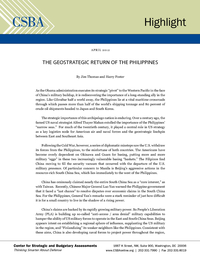
As the Obama administration executes its strategic “pivot” to the Western Pacific in the face of China’s military buildup, it is rediscovering the importance of a long-standing ally in the region. Like Gibraltar half a world away, the Philippines lie at a vital maritime crossroads through which passes more than half of the world's shipping tonnage and 80 percent of crude oil shipments headed to Japan and South Korea.
The strategic importance of this archipelago nation is enduring. Over a century ago, the famed US naval strategist Alfred Thayer Mahan extolled the importance of the Philippines’ “narrow seas.” For much of the twentieth century, it played a central role in US strategy as a key logistics node for American air and naval forces and the geostrategic linchpin between East and Southeast Asia.
Following the Cold War, however, a series of diplomatic missteps saw the U.S. withdraw its forces from the Philippines, to the misfortune of both countries. The Americans have become overly dependent on Okinawa and Guam for basing, putting more and more military “eggs” in these two increasingly vulnerable basing “baskets.” The Filipinos find China moving to fill the security vacuum that occurred with the departure of the U.S. military presence. Of particular concern to Manila is Beijing’s aggressive actions in the resource-rich South China Sea, which lies immediately to the west of the Philippines.
China has ominously claimed nearly the entire South China Sea as a “core interest,” as with Taiwan. Recently, Chinese Major General Luo Yan warned the Philippine government that it faced a “last chance” to resolve disputes over economic claims in the South China Sea. For the Philippines, General Yan’s remarks were a stark reminder of just how difficult it is for a small country to live in the shadow of a rising power.
China’s claims are backed by its rapidly growing military power. Its People’s Liberation Army (PLA) is building up so-called “anti-access / area denial” military capabilities to hamper the ability of US military forces to operate in the East and South China Seas. Beijing appears intent on establishing a regional sphere of influence, supplanting the US military in the region, and “Finlandizing” its weaker neighbors like the Philippines. Consistent with these aims, China is also developing naval forces to project power throughout the region, including aircraft carriers, guided-missile destroyers, satellite tracking ships, and nuclear-powered submarines, that could backstop militarily its demands.
Neutralizing the Philippines appears to be a critical element of China’s strategic design (continue reading)



























